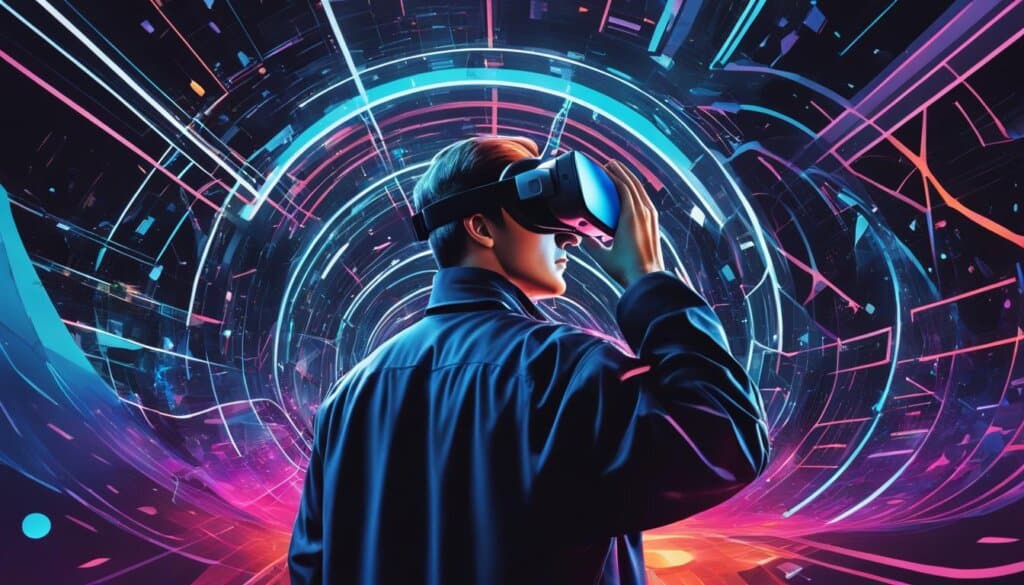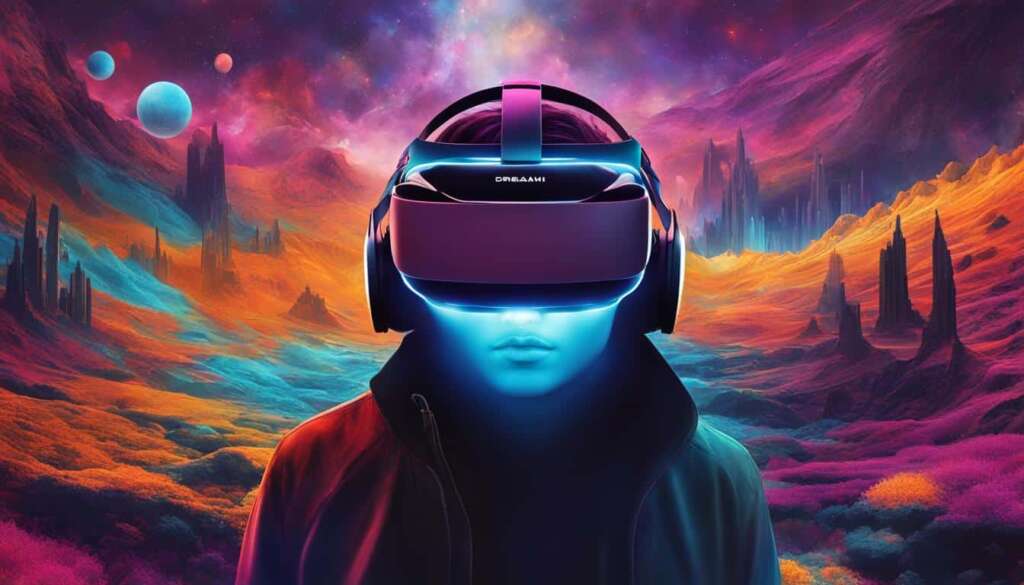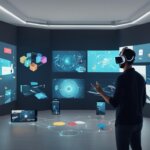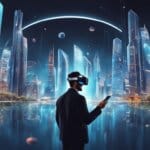Table of Contents
Virtual reality (VR) is a revolutionary technology that has transformed the way we experience the digital world. It creates an immersive world that transports users into a virtual environment that feels incredibly real. Whether it’s for entertainment, education, or any other purpose, VR offers a whole new level of engagement and interactivity.
So, what exactly is VR? It’s a simulated 3D environment that replicates reality using computer hardware and software. Users may need to wear devices like helmets or goggles to fully immerse themselves in the virtual world. VR has the power to reshape the way we learn, play, and interact with digital content.
With VR, the possibilities are endless. From gaming to training to healthcare, VR has found its way into various industries. It provides a platform where people can explore new worlds, learn new skills, and experience things that were once unimaginable. VR is not just a technological marvel; it’s a gateway to a whole new dimension of possibilities.
What is Virtual Reality?
Virtual reality is a simulated 3D environment that enables users to explore and interact with a virtual surrounding in a way that approximates reality. Users can engage with the environment using computer hardware and software, and may need to wear devices such as helmets or goggles to enhance the immersive experience. VR allows users to suspend their disbelief and accept the virtual environment as real, even if it is fantastical in nature.
Virtual reality creates a simulated environment that engages the user’s senses and perception, allowing them to navigate and interact with digital content in a highly immersive manner. The experience is powered by computer hardware and software, which creates and renders the virtual environment in three-dimensional space.
To fully experience virtual reality, users often need to wear special devices such as helmets or goggles. These devices provide a visual interface that replaces the real world with the virtual one, allowing users to see and navigate within the simulated environment. The helmets or goggles may also have built-in motion sensors, allowing users to interact with the virtual environment by moving their heads or controlling virtual objects.
One of the key features of virtual reality is its ability to trick the user’s senses into perceiving the virtual environment as real. By creating a simulated environment that closely resembles reality, virtual reality can immerse users in a virtual world that feels authentic and believable. This immersive experience can include realistic graphics, spatial audio, and even haptic feedback to further enhance the user’s sense of presence within the virtual environment.
Virtual reality allows users to escape the confines of the physical world and step into a simulated reality where the possibilities are endless. Whether exploring a fantastical realm, experiencing a historical event, or training for real-life scenarios, virtual reality opens up new dimensions of exploration, entertainment, education, and beyond.
Advancements in Virtual Reality Hardware
The hardware required for virtual reality experiences has evolved significantly over the years. Early VR systems were bulky and expensive, but advancements in computer processing power and display technology have led to more compact and affordable devices.
The current generation of VR headsets offers high-resolution displays with low latency, allowing for a more immersive visual experience. These headsets often come equipped with motion tracking sensors, enabling users to interact with the virtual environment and manipulate virtual objects using natural movements.
Additionally, haptic feedback devices such as gloves or controllers are being developed to provide users with a sense of touch within the virtual world. These devices can simulate the sensation of touch and enable users to feel and interact with virtual objects with their hands.
As technology continues to advance, the future of virtual reality holds the promise of even more realistic and seamless experiences. From improved graphics and interfaces to the integration of cutting-edge technologies such as 5G and artificial intelligence, virtual reality is poised to revolutionize various industries and reshape the way we interact with digital content.
Main Types of Virtual Reality
Virtual reality (VR) offers three main types of experiences: non-immersive, semi-immersive, and fully immersive. Each type provides different levels of immersion and interaction within the virtual environment.
Non-Immersive Virtual Reality
Non-immersive virtual reality involves a 3D simulated environment accessed through a computer screen. Users have partial control over the virtual environment, typically using a keyboard and mouse. Although it lacks the full immersion of other types, non-immersive VR still offers an engaging experience with limited interactivity.
Semi-Immersive Virtual Reality
Semi-immersive virtual reality focuses on the visual 3D aspect of the virtual environment. Users often wear a headset or glasses that enhance the visual experience. This type of VR provides a more immersive experience than non-immersive VR, allowing users to feel more present in the virtual environment.
Fully Immersive Virtual Reality
Fully immersive virtual reality delivers the highest level of immersion and interactivity. Users are fully immersed in a virtual world through the integration of sight, sound, touch, and even smell. This type of VR requires special equipment such as headsets, gloves, and motion sensors to replicate a realistic virtual environment. Fully immersive VR finds applications in various industries, including gaming, healthcare, and more.
In gaming, fully immersive VR allows players to step into the virtual world and interact with the virtual environment in a way that feels incredibly lifelike. In the healthcare industry, fully immersive VR is used for training medical professionals and simulating surgical procedures. It enables healthcare providers to practice in a safe and controlled virtual environment, enhancing their skills in a risk-free setting.
Virtual Reality vs. Augmented Reality vs. Mixed Reality
Virtual reality, augmented reality, and mixed reality are often used interchangeably, but they have distinct differences in how they create immersive experiences. Let’s explore each of these technologies in detail.
Virtual Reality
Virtual reality (VR) creates a fully immersive virtual environment that is separate from the real world. Users wear VR headsets, such as the Oculus Rift or HTC Vive, to enter a virtual realm where they can interact with virtual simulations and explore diverse digital landscapes. VR provides a sense of presence and transports users to entirely new worlds, making it popular in the entertainment industry for gaming and cinematic experiences. It also has applications in education and training, allowing individuals to learn and practice in simulated environments.
Augmented Reality
Augmented reality (AR) overlays virtual simulations onto the real-world environment, enhancing or augmenting it with digital content. AR technology, such as Microsoft HoloLens or smartphones with AR capabilities, superimposes computer-generated objects or information onto the user’s view of the real world. This technology is commonly used in applications like navigation, where users can see digital instructions overlaid on a live video feed of their surroundings. AR has also gained popularity in fields such as retail, where customers can try virtual clothes or furniture in their real-world environments before making a purchase.
Mixed Reality
Mixed reality (MR), sometimes referred to as hybrid reality, blends the physical and virtual worlds into a single space. It combines elements of both VR and AR to create an interactive environment where physical and digital objects can coexist and interact in real-time. MR headsets, like the Microsoft HoloLens 2 or Magic Leap One, allow users to manipulate virtual objects in their real-world surroundings and experience realistic digital interactions. MR has potential applications in industries such as architecture and engineering, where professionals can visualize and interact with virtual models in real-world contexts.
All three – virtual reality, augmented reality, and mixed reality – are part of the broader concept of extended reality (XR). XR encompasses the combination of virtual, augmented, and mixed reality technologies to create immersive experiences in virtual simulations or real-world environments. Collaborative VR experiences and augmented reality applications on smartphones further expand the reach of these technologies.
| Virtual Reality | Augmented Reality | Mixed Reality |
|---|---|---|
| Creates a fully immersive virtual environment. | Overlays virtual simulations onto the real-world environment. | Blends the physical and virtual worlds into a single space. |
| Uses VR headsets to transport users to virtual realms. | Utilizes AR technology to enhance real-world environments. | Employs MR headsets for interactive experiences with virtual and real objects. |
| Commonly used in gaming, training, and education. | Popular in navigation apps, retail, and advertising. | Has potential applications in architecture, engineering, and design. |
By understanding the differences between virtual reality, augmented reality, and mixed reality, we can appreciate the unique experiences and applications each technology offers. The continued advancement and integration of these technologies will shape the future of immersive digital experiences.

Applications of Virtual Reality
Virtual reality (VR) has revolutionized various industries, offering innovative solutions and immersive experiences. Let’s explore some of the key applications of VR:
1. Training
VR provides a safe and cost-effective platform for training personnel in high-risk or specialized positions. By simulating realistic scenarios, VR training allows individuals to practice their skills in a virtual environment, minimizing the potential for real-world accidents or errors. This is particularly valuable in industries such as aviation, military, and emergency services.
2. Education
In the field of education, VR offers unparalleled opportunities for immersive learning experiences. Students can explore historically significant locations, visit inaccessible environments, or dive into virtual laboratories to conduct experiments. This hands-on approach enhances comprehension, engagement, and retention of complex concepts across various subjects.
3. Healthcare
VR has vast potential in the healthcare industry. It can be used for realistic medical simulations, allowing healthcare professionals to practice complex procedures and enhance their skills in a controlled environment. Additionally, VR can facilitate patient rehabilitation, offering interactive exercises and virtual environments that aid in therapy and recovery.
4. Retail
In the retail sector, VR technology provides an immersive shopping experience for customers. It enables them to virtually try on clothes, visualize products in different settings, or explore virtual stores. By removing barriers to traditional retail, VR enhances customer engagement and empowers informed decision-making.
5. Real Estate
Real estate professionals utilize VR to create virtual tours of properties, allowing potential buyers to explore homes remotely. This technology also enables architects and developers to visualize and present architectural plans in a virtual environment, providing stakeholders with a realistic sense of the final product.
6. Entertainment
Entertainment industries like gaming, film, and tourism have embraced VR to provide captivating and immersive experiences. Gamers can step into virtual worlds, engaging all their senses for a heightened gaming adventure. VR films allow viewers to be part of the story, enhancing the cinematic experience. Additionally, VR is used in the tourism industry to offer virtual travel experiences, enabling people to explore destinations they may not be able to visit physically.
These are just a few examples of how virtual reality is transforming industries across the board. As technology continues to advance, we can expect even more exciting applications and opportunities in the future.
The Future of Virtual Reality
Virtual reality (VR) is a rapidly evolving technology that holds tremendous potential for future growth and advancements. As investment in VR and augmented reality (AR) continues to surge, VR is poised to become a pivotal element in companies’ digital transformation strategies.
Looking ahead, the future of VR is promising, with several exciting developments on the horizon. One key area of focus is the improvement of VR headsets, aiming to deliver wireless experiences with enhanced graphics and performance. These advancements will not only enhance immersion but also make VR more accessible and user-friendly to a wider audience.
Additionally, the integration of artificial intelligence (AI) is set to play a vital role in shaping the future of VR. By leveraging AI algorithms, VR experiences can be made more realistic, responsive, and interactive. This combination of VR and AI has the potential to revolutionize industries such as gaming, healthcare, and education.
Moreover, the advent of 5G technology is set to unlock new possibilities for real-time immersive experiences. With its faster data transmission and lower latency, 5G will enable seamless streaming of high-quality VR content, opening up new avenues for communication, entertainment, and collaboration.
FAQ
What is virtual reality (VR)?
Virtual reality is a simulated 3D environment that allows users to explore and interact with a virtual surrounding that approximates reality. It is created using computer hardware and software, and users may need to wear devices such as helmets or goggles to fully engage with the virtual environment.
What are the main types of virtual reality?
There are three main types of virtual reality: non-immersive, semi-immersive, and fully immersive. Non-immersive VR refers to a 3D simulated environment that is accessed through a computer screen, allowing users some control over the virtual environment. Semi-immersive VR offers a partial virtual experience focused on the visual 3D aspect, often using a headset or glasses. Fully immersive VR delivers the greatest level of virtual reality, incorporating sight, sound, touch, and even smell. Users wear special equipment and can fully interact with the environment.
What is the difference between virtual reality, augmented reality, and mixed reality?
Virtual reality creates a fully immersive virtual environment that is separate from the real world. Augmented reality overlays virtual simulations onto the real-world environment, enhancing or augmenting it. Mixed reality blends the physical and virtual worlds into a single space. All three are part of the umbrella term “extended reality” or XR, which refers to the combination of virtual, augmented, and mixed reality technologies.
What are some of the applications of virtual reality?
Virtual reality has a wide range of applications across various industries. In training, VR allows for safe and cost-effective training of personnel in high-risk or specialized positions. In education, it provides immersive learning experiences and insights into inaccessible environments. VR has potential uses in healthcare, such as treatment for disorders and doctor-patient interactions. It also has applications in retail, allowing customers to try on clothes and make more informed decisions. Real estate can benefit from VR through virtual tours and visualization of architectural plans. Finally, entertainment industries like gaming, film, and tourism are also utilizing VR to provide immersive experiences to viewers and users.
What is the future of virtual reality?
Virtual reality is a rapidly growing technology with immense potential for future advancements. Investment in VR and AR is projected to multiply in the next few years, with VR becoming a key element in companies’ digital transformation plans. Future developments include wireless VR headsets with improved graphics and performance, integration of artificial intelligence, and the utilization of 5G technology for real-time immersive experiences. Over time, VR is expected to become more affordable, user-friendly, and widely adopted in various industries and everyday life.













